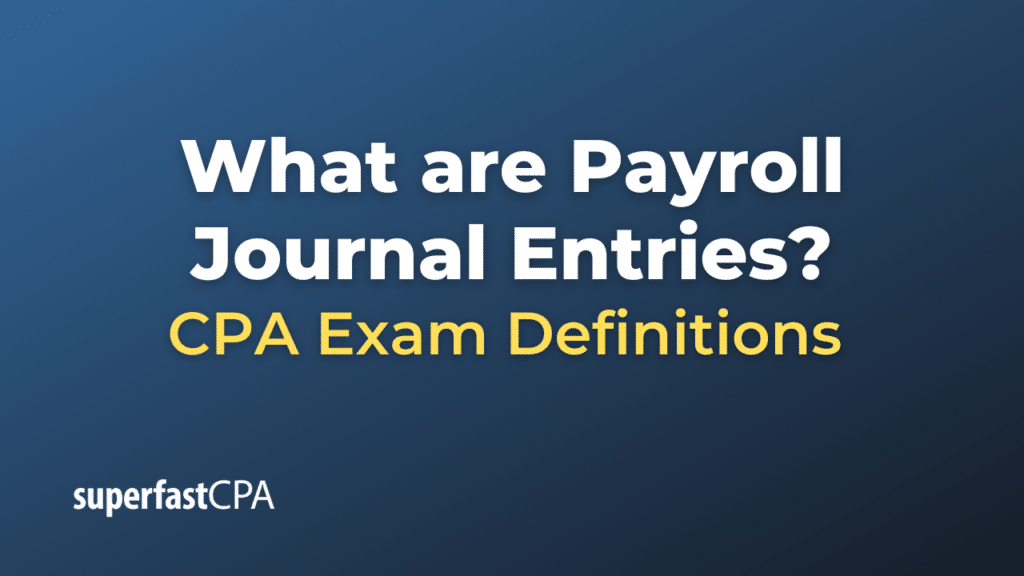Payroll Journal Entries
Payroll journal entries are used in a company’s general ledger to record its payroll transactions. They reflect all aspects of the payroll process, including gross wages and salaries, employee deductions, and the employer’s payroll tax liabilities.
Here are some of the most common payroll journal entries:
- Salaries or Wages Expense: This is a debit entry that records the total gross wages or salaries earned by all employees for the period. This is an expense for the company and will be used in calculating net income.
- Employee Deductions: These are credit entries that represent amounts withheld from employees’ pay. This can include federal, state, and local income taxes, Social Security and Medicare taxes (FICA in the U.S.), health insurance premiums, retirement contributions, union dues, and other deductions. These are liabilities for the company until they are paid to the appropriate authorities or entities.
- Employer Payroll Taxes: This is a debit entry that records the employer’s share of Social Security and Medicare taxes (again, in the U.S.), federal and state unemployment taxes, and any other taxes that the employer is required to pay on wages and salaries. These are also expenses for the company.
- Net Pay: This is a credit entry that represents the total amount of cash or other assets paid to employees (gross pay minus employee deductions). This reduces the company’s cash or other assets.
- Payroll Liabilities : These are credit entries that represent the employer’s remaining liabilities after paying net pay to employees. These could include the employee deductions that have not yet been paid to the appropriate authorities or entities, as well as the employer’s payroll taxes.
By making these entries for each payroll period, a company maintains an accurate record of its payroll expenses and liabilities. This information is then used in preparing financial statements and in managing the company’s cash flows and other financial operations.
Example of Payroll Journal Entries
Let’s consider an example of a payroll journal entry for a small company called “GreenScape Landscaping.” The company has one employee named David. David earns a gross wage of $1,000 per pay period. Let’s assume that $200 is withheld for federal income tax, $50 for state income tax, and $76.50 for Social Security and Medicare (FICA). The company’s matching portion of FICA is also $76.50.
Here’s how you would record this payroll:
Journal Entry 1: Record Gross Wage and Deductions
- Debit Salary Expense $1,000 (this represents David’s gross earnings)
- Credit Federal Income Tax Payable $200 (this represents the federal tax that was withheld from David’s paycheck)
- Credit State Income Tax Payable $50 (this represents the state tax that was withheld from David’s paycheck)
- Credit FICA Payable $76.50 (this is David’s portion of FICA that was withheld from his paycheck)
- Credit Wages Payable $673.50 (this is the net amount that will be paid to David, i.e., gross wages minus all deductions)
Journal Entry 2: Record Employer’s Payroll Taxes
- Debit Payroll Tax Expense $76.50 (this represents the employer’s portion of the FICA tax)
- Credit FICA Payable $76.50 (this adds to the liability the company will need to pay to the government)
When the company pays David his net wages, it would make another journal entry to record the payment:
Journal Entry 3: Record Payment of Net Wages
- Debit Wages Payable $673.50
- Credit Cash $673.50
Likewise, when the company pays the tax withholdings and its share of FICA to the government, it would record the following:
Journal Entry 4: Record Payment of Payroll Taxes
- Debit Federal Income Tax Payable $200
- Debit State Income Tax Payable $50
- Debit FICA Payable $153 ($76.50 from David and $76.50 from the company)
- Credit Cash $403
These entries ensure that the company correctly records its payroll expenses, its liabilities for tax withholdings and payroll taxes, and the payment of net wages to its employee.













